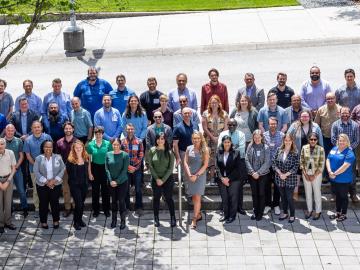
Filter News
Area of Research
- Advanced Manufacturing (4)
- Biology and Environment (36)
- Building Technologies (3)
- Clean Energy (69)
- Computational Biology (1)
- Computational Engineering (2)
- Computer Science (7)
- Electricity and Smart Grid (1)
- Fuel Cycle Science and Technology (1)
- Functional Materials for Energy (1)
- Fusion and Fission (27)
- Fusion Energy (13)
- Isotope Development and Production (1)
- Isotopes (26)
- Materials (58)
- Materials for Computing (8)
- National Security (57)
- Neutron Science (19)
- Nuclear Science and Technology (17)
- Quantum information Science (4)
- Sensors and Controls (1)
- Supercomputing (94)
News Topics
- (-) Buildings (57)
- (-) Cybersecurity (35)
- (-) Frontier (43)
- (-) Fusion (55)
- (-) Isotopes (53)
- (-) Machine Learning (48)
- (-) Microscopy (51)
- (-) National Security (65)
- (-) Security (24)
- (-) Space Exploration (25)
- (-) Summit (58)
- 3-D Printing/Advanced Manufacturing (124)
- Advanced Reactors (34)
- Artificial Intelligence (94)
- Big Data (57)
- Bioenergy (92)
- Biology (100)
- Biomedical (59)
- Biotechnology (22)
- Chemical Sciences (66)
- Clean Water (30)
- Climate Change (101)
- Composites (28)
- Computer Science (192)
- Coronavirus (46)
- Critical Materials (27)
- Decarbonization (80)
- Education (4)
- Element Discovery (1)
- Emergency (2)
- Energy Storage (109)
- Environment (196)
- Exascale Computing (38)
- Fossil Energy (6)
- Grid (65)
- High-Performance Computing (87)
- Hydropower (11)
- Irradiation (3)
- ITER (7)
- Materials (144)
- Materials Science (141)
- Mathematics (9)
- Mercury (12)
- Microelectronics (3)
- Molten Salt (8)
- Nanotechnology (60)
- Net Zero (14)
- Neutron Science (131)
- Nuclear Energy (109)
- Partnerships (46)
- Physics (62)
- Polymers (33)
- Quantum Computing (35)
- Quantum Science (69)
- Renewable Energy (2)
- Simulation (49)
- Software (1)
- Statistics (3)
- Sustainable Energy (129)
- Transformational Challenge Reactor (7)
- Transportation (97)
Media Contacts
Joe Tuccillo, a human geography research scientist, leads the UrbanPop project that uses census data to create synthetic populations. Using a Python software suite called Likeness on ORNL’s high-performance computers, Tuccillo’s team generates a population with individual ‘agents’ designed to represent people that interact with other agents, facilities and services in a simulated neighborhood.
The contract will be awarded to develop the newest high-performance computing system at the Oak Ridge Leadership Computing Facility.

ORNL hosted the Mid-South Regional Chapter of the American Society for Photogrammetry and Remote Sensing, or ASPRS. Participants spanning government, academia and industry engaged in talks, poster sessions, events and workshops to further scientific discovery in a field devoted to using pictures to understand changes to the earth’s inhabitants and landscape.

A newly established internship between ORNL and Maryville College is bringing cybersecurity careers to a local liberal arts college. The internship was established by a Maryville College alumni who recently joined ORNL.

Oak Ridge National Laboratory has named Troy A. Carter director of the Fusion Energy Division in ORNL’s Fusion and Fission Energy and Science Directorate, or FFESD.

As a data scientist, Daniel Adams uses storytelling to parse through a large amount of information to determine which elements are most important, paring down the data to result in the most efficient and accurate data set possible.

Oak Ridge National Laboratory scientists have developed a method leveraging artificial intelligence to accelerate the identification of environmentally friendly solvents for industrial carbon capture, biomass processing, rechargeable batteries and other applications.

Despite strong regulations and robust international safeguards, authorities routinely interdict nuclear materials outside of regulatory control. Researchers at ORNL are exploring a new method that would give authorities the ability to analyze intercepted nuclear material and determine where it originated.

A new study conducted on the Frontier supercomputer gave researchers new clues to improving fusion confinement. This research, in collaboration with General Atomics and UC San Diego, uncovered that the interaction between ions and electrons near the tokamak's edge can unexpectedly increase turbulence, challenging previous assumptions about how to optimize plasma confinement for efficient nuclear fusion.

Leadership Tennessee has named Clarice Phelps to its 2024–2025 Signature Program Class XI to collaborate with professionals statewide to address Tennessee’s most serious issues.


